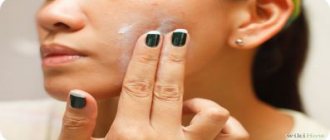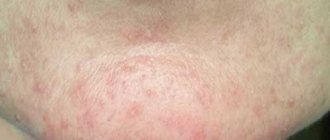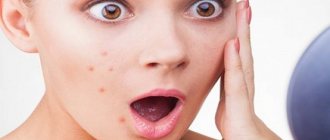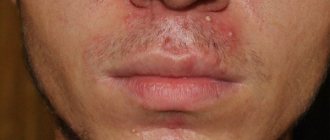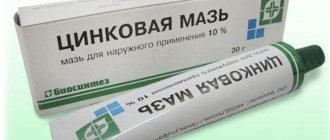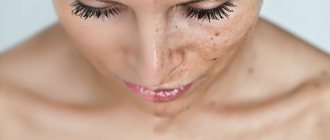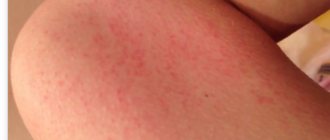Causes and risks of developing pathology
The causes of the pathology have not been thoroughly studied, but most doctors believe that ring-shaped erythema is caused by fungi and infectious agents, or is a reaction of the immune system to an allergen (especially medications).
Also, risk factors for the occurrence of Darier's erythema include the following diseases:
- lupus erythematosus;
- helminthic infestation;
- intoxication;
- focal infections;
- disruptions in the functioning of the endocrine system;
- mycoses;
- weakened immunity;
- individual intolerance to drugs;
- dysproteinemia;
- oncological formations;
- genetic predisposition.
The combination of several risk factors increases the likelihood of pathology.
Causes
Scientists often associate the causes of erythema annulare with genetic predisposition. In addition, people with the following problems are susceptible to the disease:
- allergic reactions;
- autoimmune pathologies;
- malignant tumors;
- poisoning of the body;
- Lyme disease (develops due to a tick bite);
- rheumatism;
- helminthiasis;
- pulmonary tuberculosis;
- endocrine diseases;
- fungus, cutaneous mycosis;
- weakened immune system;
- disruptions in the gastrointestinal tract.
Scientists have not yet reached a consensus on the factors contributing to the development of ring erythema. Often, patients do not have clearly defined reasons for its appearance.
Symptoms
Symptoms of the disease vary depending on the type of pathology. There are the following clinical types of ring-shaped erythema:
- Vesicular - characterized by the appearance of vesicles - elevations above healthy skin, with fluid-filled bubbles. The formations are localized along the edges of the spots.
- Peeling - the course of the pathology is accompanied by the peeling off of dead epidermal cells along the contour of the rash.
- Persistent microgarland-shaped - formed from small spots (up to 1 cm in circumference).
- Simple garland-shaped - characterized by short-term exacerbation. The redness goes away within a few hours (maximum - a few days).
General signs of the disease:
- formation of red spots on the surface of the skin;
- rashes are most often localized on the cheeks, stomach, sides of the chest, and on the front surface of the shoulder;
- tendency to rapidly increase the area of spots (can reach 20 cm in diameter);
- adjacent formations can merge with each other into an arcuate surface;
- redness rises above healthy skin;
- New ones appear near old formations;
- characterized by burning, slight itching;
- inside the reddened ring, the surface of the epidermis retains normal pigmentation or turns pale (if pathology occurs in children);
- The disease is characterized by paroxysmal episodes: lesions can suddenly disappear and recur;
- A distinctive feature is that the spots form a lace pattern on the surface of the body.
The relationship between the pathology and overheating, hypothermia and insolation has been noted - due to such external influences, a relapse of the disease occurs.
Diagnostics. Differential definition of disease
If you detect rashes similar in description to ring-shaped erythema, you must contact a dermatologist or dermatovenereologist for consultation, examination and examination.
To diagnose annular erythema, the following types of studies are used:
- serological;
- to identify cancer cells;
- histopathological;
- mycological;
- dermal biopsy;
- blood test (general and biochemical).
By using these diagnostic techniques, a number of diseases with similar symptoms are excluded:
When the diagnosis is finally established, the patient is registered at a dispensary and therapy is prescribed to combat the pathology and the causes of its occurrence.
Treatment
Therapeutic measures can be very different due to the variety of reasons that can cause erythema annulare. Treatment is initially aimed at combating the source of the problem - pathologies of the gastrointestinal tract, endocrine system, viral or infectious diseases.
Complex therapy against ring-shaped erythema may include:
- antibiotics;
- disinfectants, antiseptics;
- antihistamines;
- healing;
- corticosteroids;
- vitamin and mineral complexes;
- homeopathic remedies (therapy for pregnant women and children);
- immunostimulants and modulators;
- antimalarial drugs.
The pathology is prone to chronicity, but with comprehensive treatment and adherence to a hypoallergenic diet, long periods of remission can be achieved. After a successful course of therapy, erosions with persistent color may remain at the site of the spots.
In the absence of proper treatment, the disease progresses with exacerbations in the spring and summer.
Features of the disease and its treatment in children
Diagnosis is carried out according to the same principle as in adults, but more gentle treatment is prescribed. For the treatment of Darier's erythema in children, the following is used:
- Hyposensitizing drugs (calcium, sodium thiosulfate).
- Antihistamines (Fenistil, Zyrtec, Aleron, Suprastin).
- Antibiotics (Penicillin, Azithromycin tablets or suspension, Doxycycline, Erythromycin).
- Fluoroquinol drugs (Rotomox, Abaktal).
- Topical corticosteroids (Hydrocortisone).
Clinical observation and long-term use of homeopathic remedies are recommended to consolidate the positive result.
Treatment methods
To eliminate the symptoms of annular erythema, antihistamines (Pernovitin, Trental, etc.) may be prescribed. Also, sodium and calcium thiosulfate preparations are prescribed.
In some cases, the use of broad-spectrum antibiotics is indicated. Most often, for annular erythema, drugs from the penicillin group are used: Doxycycline, Erythromycin, Azithromycin; fluoroquinol drugs, for example, Cyflox.
Vitamin therapy is very important for annular erythema. It is especially useful to take vitamins of groups A, B and group E.
In severe cases of the disease, medications containing corticosteroids or anabolic compounds are prescribed. Sometimes the prescription of antimalarial drugs is indicated.
Antiseptic and disinfectant preparations are used externally for erythema. Can be assigned:
- wet compresses with a 2% solution of amidopyrine and endocordin lactate;
- treatment of the affected skin with aerosol preparations containing polcortolone, sodium thiosulfate solution;
- ointments that accelerate the rate of epithelization;
- antihistamine gels;
- creams containing low concentrations of corticosteroids.
For the treatment of ring-shaped erythema in children, it is recommended to use homeopathic remedies. For example, Barium muriaticum 6, three granules between breakfast and lunch, or Sepia 6, one granule in the evenings. You need to take the medications until the symptoms of erythema completely disappear. However, success in curing this disease can only be achieved by getting rid of the underlying disease that led to the appearance of annular erythema.
Prevention measures and forecasts
Despite its chronic course, ring-shaped erythema responds well to treatment if it is started in the early stages of the disease. The formation does not develop into malignant, but this does not mean that the prescribed treatment can be ignored.
- Timely treatment of infectious, viral, fungal diseases.
- Adhering to a hypoallergenic diet.
- Avoid hypothermia, insolation, overheating.
- Observe safety precautions when working with aggressive chemicals.
Ring-shaped erythema is prone to relapses, but with systematic and comprehensive treatment, exacerbation of the disease can be avoided. Counting on a successful fight against pathology, one must not lose sight of the accompanying problems that can activate it.
Add a comment Cancel reply
Popular:
Free doctor consultation
No catch. Just leave your question in the comments and a specialist will answer it.
A complete list (more than 150 items) with prices is updated regularly.
Identify the fungus from the photo
When should you go to see a doctor? We invite you to find out what nail fungus looks like at different stages.
Can it be cured in 1 day? Types, how to avoid infection, routes of transmission, medications.
Can it be cured in 1 day? Types, how to avoid infection, routes of transmission, medications.
How to remove warts yourself?
Warts in children, papillomas and condylomas in adults, what is the danger of removing them at home?
Thrush in women
Thrush or vaginal candidiasis is known firsthand to every second woman.
Dermatitis: photo and description
It is possible that the spot on the skin is not a fungus at all. Compare the photos to make sure.
If there is a characteristic rash, then you need to run to the doctor, or at least to the pharmacy.
Candidiasis in men
Representatives of the stronger half of humanity for some reason believe that thrush is the prerogative of women, but this is not so.
Forecast
Erythema is a skin reaction, a signal that a malfunction has occurred in the human body. To eliminate this manifestation, complex treatment is necessary. With timely access to specialists and adequate therapy, the disease can be cured successfully. Symptoms disappear completely within a few weeks of starting treatment.
If the cause of the pathology has not been identified, the erythema goes away on its own. However, there is a high risk of its re-formation. If this happens, the patient is recommended to undergo a detailed examination of the body for the presence of a hidden infection and its treatment.
To prevent ring-shaped erythema from occurring in a child, the following preventive measures are necessary:
- timely detection and treatment of various diseases;
- compliance with personal hygiene rules;
- absence of bad habits;
- balanced diet.
The cause of skin diseases is often some other pathology, and annular erythema is no exception. Noticeable red spots in the shape of rings, as a rule, appear in young and adult men; the disease affects women much less frequently. Another name for this pathology is anular erythema.
Causes of ring-shaped spots on the skin
Ring-shaped spots on the skin may be erythema annulare, which is also called persistent or anular erythema. This disease can be caused by various factors and is prone to relapse. It is most often diagnosed in children, adolescents and young men.
To date, the exact reasons for the development of erythema annulare are not yet known to scientists. However, experts make some assumptions about the connection between its occurrence and the impact of certain factors - viruses, infections and other health problems.
Darrieus centrifugal spot
The origin of Daria's annular erythema raises especially many questions among scientists, since it has not yet been possible to identify the causes of the appearance of such a malaise.
Some experts suggest that the development of this type of disease may be associated with fungal infections of the skin. There is also a theory that skin symptoms are based on autoimmune processes or genetic predisposition. Darier's erythema can also occur under the influence of certain medications.
What diseases is it typical for?
The development of annular erythema can be provoked by a number of ailments, including:
- Pathologies of the digestive tract.
- Various types of intoxication of the body.
- Bacterial and viral lesions.
- Focal infections represented by tonsillitis, cholecystitis, osteomyelitis, sinusitis, etc.
- Disturbances in the functioning of the immune system.
- Fungal skin diseases.
- Endocrine diseases.
- Oncological processes. Erythema may be part of the paraneoplastic syndrome (complex of symptoms of cancer).
- Parasitic infections.
- Dysproteinemia (with this condition the ratio of proteins in the body is disturbed).
Since today the mechanism of development of annular erythema remains not fully understood, it is not yet possible to find out what factors can trigger its progression. This makes therapy somewhat more difficult and reduces its effectiveness.
Annular redness due to rheumatism
The appearance of ring-shaped erythema can sometimes be a specific manifestation of rheumatism in the active phase. This pathology is most often diagnosed in childhood and adolescence, as well as in adult patients under 30 years of age. Red spots on the skin can appear in various phases of the rheumatic process; they can be observed with polyarthritis or rheumatic carditis, and sometimes become apparent before other symptoms of rheumatism appear. With the current rheumatic process, erythema can warn of another attack of the disease or its exacerbation.
Ring spot for viral infections
Some viral infections can lead to changes in the body's functioning and trigger the appearance of erythema migrans. This is a chronic disease, which is similar in its characteristics to dermatosis. Most often it is diagnosed in middle-aged men, and doctors assure that this form of the disease is easier to treat than other types of annular erythema. Erythema migrans may appear after bites from ticks and other insects.
Causes
Today, the specific factors leading to the occurrence of erythema have not been fully studied. Most experts tend to assume that this is a consequence of a reactive process, which is caused by infections and drug intolerance.
There are frequent cases when the centrifugal form of erythema is observed in people suffering from acute leukemia, lupus erythematosus, scarlet fever, measles or fungal skin infections. (You can also learn about fungal infections on our website. Read about fungus on the toenails here, about foot fungus in this article, about fungus on the hands at this address).
Factors provoking the disease:
- infectious inflammation (granuloma, tonsillitis, cholecystitis and others);
- intoxication of the body;
- mycosis of the skin;
- problems in the functioning of the nervous or endocrine system;
- cancerous formations;
- discrepancy with the norm of quantitative balance of blood proteins.
It is assumed that erythema may be genetic. There is a tendency for pathology to manifest itself in blood relatives.
Symptoms
Classic ring-shaped erythema of Darier is characterized by an acute onset:
Rings with annular erythema often grow and merge, sometimes they form arcs or garlands. It is possible to form openwork elements. The central part of such spots is covered with smooth and pale skin, and the outer edge rises somewhat above the surrounding skin and has a bright red or purple-violet color. With rheumatic erythema, the color of the edging is most often not very pronounced - it appears pale pink.
The rings usually remain on the skin for a couple of weeks, then disappear, leaving behind areas with stagnant pigmentation.
Sometimes spots appear on the skin in just half an hour, for example, when exposed to the sun or cold, and then disappear just as quickly. It is possible to develop a chronic form of the disease, which worsens during the off-season, as well as in the summer.
Features in children
In children, ring-shaped erythema of rheumatic origin is most often diagnosed; it can occur with the development of polyarthritis, rheumatic carditis or rheumatism. Experts call this disease a special term - Leiner's annular erythema. The disease has a number of specific symptoms:
- Bright red spots, about the size of a five-kopeck coin, appear on the skin of the baby’s body. They tend to expand and merge with each other.
- They do not cause any discomfort to the child and do not cause the desire to scratch.
- The spots are present on the body for quite a long time and disappear after successful treatment of the underlying rheumatological disease.
If the underlying disease becomes chronic, erythema annulare in children often recurs. Doctors are confident that this development of events is associated with severe complications in the heart and blood vessels.
Types of ring-shaped erythema
This disease has several types and different clinical manifestations. The following types of ring-shaped erythema are distinguished:
- Centrifugal - a characteristic feature is a large number of erythemas in the form of a roller, which rise above the skin. Over time, the shape of the lesion changes and it grows.
- Erythema migrans is a chronic form of pathology, the signs of the inflammatory process are similar to dermatosis. The disease becomes a consequence of bacterial or viral infections.
- Rheumatic - becomes a direct sign of the presence of rheumatism. A characteristic manifestation is pale pink, barely visible spots. Occurs in children and adolescence.
According to clinical manifestations, erythema annulare is divided into:
- garland-shaped - spots appear for a short period of time;
- vesicular - instantaneous appearance and rapid disappearance, cavities with exudate (vesicles) are formed along the periphery of the rings;
- peeling - the outer border of the formation peels off.
Erythema Daria
As a rule, this disease is associated with cancer, in some cases it is a consequence of myeloproliferative pathologies. Centrifugal erythema of Darier is observed as a paraneoplastic process in patients over 50 years of age, equally in women and men. The pathology develops acutely and can last for a long time (from several months to tens of years). First signs:
- Swelling, scaly spots of pink or red color.
- Next, a large number of erythematous elements appear in the shape of a ring with an urticarial edge, a pale, smooth and flat middle. Diameter - 1-2 cm, over time the color becomes brownish.
- As the element grows, its diameter reaches 15 cm.
- The rings are formed into garlands, arcs and scalloped elements.
Diagnostics
Even experienced doctors may encounter some difficulties when diagnosing ring-shaped erythema, because its manifestations resemble many dermatological ailments, ranging from seborrheic eczema and lichen to syphilis. Therefore, to make an accurate diagnosis you may need:
- Microscopic examination of skin scrapings.
- Performing various blood tests.
- Histology of biopsy (material from the affected area).
- Carrying out a complex of mycological tests.
To find out the exact reasons for the appearance of erythema, sometimes consultation with other specialists is required, for example, a rheumatologist, gastroenterologist, endocrinologist and oncologist.
Treatment
Therapy for ring-shaped erythema should be exclusively comprehensive and may include:
- Treatment of conditions suspected of causing skin spots. In particular, chronic foci of infection are sanitized, the functioning of the digestive tract and other organs and systems of the body is stabilized.
- Antibiotic therapy.
- Taking hormonal medications.
- Treatment of lesions.
- Using traditional medicine techniques.
- Organization of dietary meals.
What is erythema annulare
Many demotic diseases have similar external signs, so only a dermatologist can determine the type of pathology. Ring-shaped erythema is a disease that belongs to infectious-toxic diseases of a chronic nature. Unlike other skin diseases, this can be recognized independently. A typical manifestation is ring-shaped spots on the skin of a bright red color, they do not peel off, and are accompanied by general malaise, headache, fever, and swelling.
What causes the disease?
The skin is closely connected with all organ systems, therefore it is sensitive to changes occurring in the body. The appearance of red spots in the form of rings on it is not an independent disease, but a signal of a disorder, the cause of which remains to be determined. Causes of erythema annulare include:
- defect of the immune system, in particular the lymphocyte link;
- malignant tumors;
- intoxication of various origins;
- Lyme disease (borreliosis, transmitted through a tick bite);
- rheumatic and other autoimmune diseases;
- helminthic infestations, intestinal and tissue forms (strongyloidiasis, ascariasis, trichinosis);
- allergic reactions;
- chronic local foci of infection (sinusitis, osteomyelitis);
- tuberculosis;
- hormonal disorders;
- fungal infections;
- disruption of the digestive tract.
Idiopathic annular erythema of Darier is often encountered - in this case, even a thorough examination does not reveal the possible cause of the disease.
How does it arise?
The appearance of erythema is associated with a pathological vascular reaction: the capillaries located in the skin expand, the blood flow in them slows down, and the fluid pressure in their lumen increases. As a result, part of the plasma escapes into the tissue, which leads to local edema - this is how raised edges or a platform appear in the annular erythema. Following the liquid, T-lymphocytes emerge - cells of the immune system responsible for recognizing foreign agents and destroying the body’s own infected cells and tumor cells. Their role in the occurrence of erythema is not completely clear, but they indicate a close connection of the disease with the functioning of the immune system.
Erythema annular centrifugal is capable of peripheral growth. In the center of the ring, the pathological process subsides, so the skin acquires its usual color and thickness, and along the periphery a shaft of dilated capillaries, T-lymphocytes and cellular edema remains. The ring grows in size from the center to the edges - this growth is called centrifugal.
How does it manifest?
Initially, nummular erythema appears on the skin - a rounded red spot, slightly raised above its surface, similar to a coin. When pressed, the erythema turns pale or disappears completely. A center of clearing gradually forms in the center, the skin becomes pink, then acquires a normal or paler color. Sometimes, in the center of nummular erythema, several round-shaped foci of clearing are simultaneously formed; in this case, several rings form.
In some cases, peeling or blisters appear on the surface of the changed skin. The boundaries of the formation remain red or pink and gradually “spread” wider and wider, which leads to an increase in the diameter of the ring. The edge of the ring can be flush with the skin or slightly raised above it.
Ring-shaped erythemas of varying degrees of maturity can be located in the same location; the rings often merge with each other. Thus, fancy arched contours and wavy edges of the spots are formed. Skin changes are occasionally accompanied by itching and soreness, which depends on the underlying cause of the disease. Symptoms of annular erythema occur against the background of other signs of the disease:
- The infectious nature of erythema is indicated by signs of intoxication - fever, weakness, aching muscles and joints, and lack of appetite. Migratory annular erythema most often occurs when infected with Borrelia as a result of a tick bite (Lyme disease, Lyme borreliosis). In the center of the redness, the primary affect is visible - the site of the tick bite in the form of a rounded hemorrhagic crust or erosion. Often characteristic target-shaped erythema is formed when a smaller ring is located inside a larger one in diameter.
- With rheumatism, damage to connective tissue structures comes to the fore - pain in joints, muscles, limited mobility, changes in skin quality, increased bleeding of blood vessels, prolonged rise in temperature above 38 degrees C°, impaired cardiac activity. As a rule, the borders of the rings in this case are pale pink and indistinct; their localization can be anywhere.
- Allergic erythema is usually bright, the swelling is well expressed, and can be combined with a rash like urticaria on other parts of the body, with Quincke's edema, conjunctivitis, and rhinitis. It is also characterized by skin itching of varying intensity.
- A malignant neoplasm is indicated by prolonged weakness, weight loss, bursting pain in the long tubular bones of the extremities, enlarged lymph nodes, and a prolonged increase in temperature to subfebrile levels (up to 38 degrees C°).
Symptoms of ring-shaped erythema
The disease has a specific development algorithm. Symptoms of erythema annulare begin with the formation of red or pinkish-yellow scaly patches on the skin. The disease begins to progress and ring-shaped elements are formed, rising slightly above the surface. The color at the edge of the rings is brighter, the diameter can be more than 15 cm, and in some cases itching appears in the area of the rash. Erythematous elements have the following characteristic external signs:
- Ring-shaped lesions on the skin.
- The edges are urticarial, the center is pale.
- The surface inside the ring is smooth and flat.
- Lesions tend to grow peripherally.
- With erythema, the lesions can unite, forming a “garland” and an “arc”.
- The lesions will exist for 2-3 weeks, then they will begin to disappear, leaving persistent pigment spots on the skin. Then new ring-shaped elements will begin to appear again.
- The disease is usually localized on the back, torso, limbs and abdomen. Rarely, lesions form on the buttocks, lips, neck or face.
How to make a diagnosis?
Diagnosis of ring-shaped erythema is not difficult due to the characteristic appearance of the spots on the skin. If it is necessary to distinguish the disease from granuloma annulare, which has similar symptoms, a dermatologist takes a section of altered tissue (biopsy) for histological examination. In the laboratory, microscopic sections are prepared from the sample, stained, and a pathologist examines the resulting preparations under a microscope. Skin changes with erythema include:
- expansion of capillaries of the dermis;
- accumulations of lymphocytes around blood vessels;
- slight swelling of cells and intercellular space of the epidermis;
- moderate swelling of the dermis.
To find out the cause of annular erythema, the doctor conducts a number of additional tests, starting with the simplest ones - a general clinical analysis of blood, urine and biochemical analysis of plasma. Changes in them suggest which direction to move next. Thus, helminthic infestation is characterized by slight anemia, eosinophilia, and accelerated ESR. During allergic reactions, the protein content in the plasma increases, in particular immunoglobulin E. Malignant neoplasms manifest themselves by a decrease in hemoglobin, red blood cells in the blood, a change in the leukocyte formula, and an acceleration of ESR. The diagnosis of Lyme borreliosis is confirmed by a serological test - immunoglobulins M and G to borrelia are detected in the blood serum.
The doctor uses instrumental studies (ultrasound, CT, MRI, X-ray, ECG, ECHO-CG) if any changes were detected as a result of the examination of the patient or laboratory tests.
How to cure?
Effective treatment of ring-shaped erythema is possible by identifying the cause of the disease and eliminating it. Therapy is prescribed by a dermatologist together with a specialist who deals with the underlying disease: neurologist, rheumatologist, endocrinologist, immunologist, infectious disease specialist. The need for hospitalization is determined based on the person’s general condition and concomitant pathology. As a rule, patients receive therapy on an outpatient basis.
Video: Removing erythema using the Ellipse device
Local treatment includes
- Antihistamine ointments, creams, gels (Fenistil-gel) - they eliminate swelling, redness, itching associated with the release of histamine. Effective in cases of allergic nature of the disease, since histamine plays a key role in the development of a hypersensitivity reaction.
- Ointments containing zinc compounds (Skin-cap, Desitin) - their mechanism of action is not fully understood, but they effectively eliminate inflammation in the dermis and epidermis, itching, and flaking. Unlike hormonal and antihistamines, they are practically safe.
- Glucocorticoid ointments, creams (Akriderm, Sinaflan) - reduce the activity and slow down the proliferation of T-lymphocytes, thereby eliminating the main cause of local changes in the skin. They can only be used as prescribed by a doctor, strictly following the instructions. Otherwise, serious adverse reactions occur in the form of skin atrophy, severe bacterial and fungal infections.
Treatment of ring-shaped erythema
This pathology is not an independent disease, so effective therapy will be determined by determining the root cause. Treatment of annular erythema should be prescribed by a dermatologist and a doctor who specializes in the underlying disease: rheumatologist, immunologist, neurologist, endocrinologist, infectious disease specialist. Whether hospitalization is necessary is determined after examination and determination of the patient’s general condition. As a rule, treatment is carried out on an outpatient basis, using local and systemic drugs.
Local therapy:
- Antihistamine gels, creams, ointments. The drugs eliminate itching, redness, and swelling, which are caused by histamines. Effective in cases of allergic nature of the pathology, the drugs stop developing hypersensitivity.
- Medicines with zinc (Desitin, Skin-cap). The principle of action of the products has not been fully studied, but they effectively eliminate itching, peeling, and inflammation in the dermis.
- Glucocorticoid creams, ointments (Sinaflan, Akriderm). The products slow down reproduction and reduce the activity of T-lymphocytes, which helps stop changes on the surface of the skin. Such medications can only be used as prescribed by a doctor, in full compliance with the rules from the instructions. If used incorrectly, it can cause fungal and bacterial infections and skin atrophy.
Systemic therapy:
- Antibiotics. Their use is justified in case of infectious nature of the pathology, for example, Lyme borreliosis. For treatment, use cephalosporins or penicillin for 10 days.
- Desensitizing medications (calcium chloride, sodium thiosulfate). They help remove toxins and allergens from the bloodstream, stabilize the membranes of immune cells, reduce the permeability of the vascular wall, stopping the release of histamine.
- Cytostatics (Methotrexate). The medication inhibits the maturation and reproduction of immune cells, which reduces the manifestation and activity of autoimmune diseases.
- Antihelminthics. They are prescribed to the patient if, during diagnosis, worm eggs were detected in the stool; in some cases, several courses of therapy are carried out.
- Glucocorticoids. Use injections or tablets for long-term persistent erythema and rheumatic pathologies.

